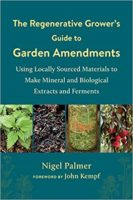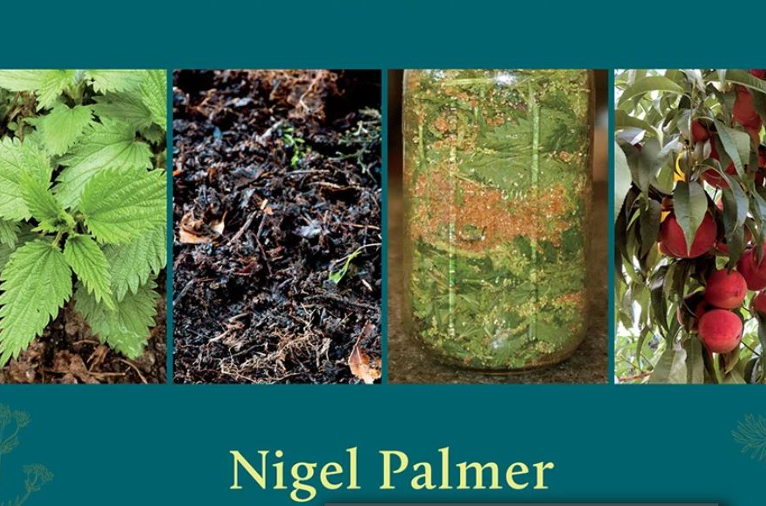 The following excerpt is from Nigel Palmer’s new book The Regenerative Grower’s Guide to Garden Amendments: Using Locally Sourced Materials to Make Minerals and Biological Extracts and Ferments (Chelsea Green Publishing, August 2020) and is reprinted with permission from the publisher.
The following excerpt is from Nigel Palmer’s new book The Regenerative Grower’s Guide to Garden Amendments: Using Locally Sourced Materials to Make Minerals and Biological Extracts and Ferments (Chelsea Green Publishing, August 2020) and is reprinted with permission from the publisher.
A New Garden Model
We all use models to help explain the world around us. For example, when a traffic light turns green, many of us reflexively hit the accelerator and go. We don’t check whether any cars are coming from the left or right, because our mental model assumes that cross traffic has stopped. Another example: At day’s end, we don’t worry when the sun goes down and it gets very cold, because we have a clear certainty that the sun will rise again tomorrow morning, providing light and warmth. Our mental models define our reality.
We tend our gardens and farm fields based on our mental models about how plants grow. An example of a plant cultivation model is the assumption that simply putting a tomato seed into the ground, and occasionally watering it, will eventually produce a tomato plant that bears a good crop of fruits. Some gardening and farming models require that the soil be tilled and all weeds removed before seeds can be planted. Some models call for regular additions of nitrogen fertilizer and lime. Plants are tenacious, they will grow under the most difficult of circumstances, and even if a cultivation model is far from ideal, the plants may grow pretty well. Many a good-tasting tomato has been grown following conventional gardening models, but are these the most nutrient-dense tomatoes possible to grow? Can the nutrient density of the crops grown be measured? The answers to these questions lie ahead.
Rediscoveries of forgotten or discarded ideas about plant growth—such as that truly healthy plants can thwart soilborne and airborne pathogens, as well as insect pests, and provide significantly higher levels of nutritional value—are the inspiration for a new model for tending gardens and farm fields, one that focuses on the entire ecosystem that the plant grows in. And from these ideas arises a new garden model that makes use of a different set of tools and gardening practices.
The old plant model that most gardeners followed for decades envisions a one-way flow of nutrients from the soil into the plant, with no biological interaction involved. In this model the soil isn’t given much importance—it’s just a matrix for root growth. Gardeners add nutrients to the soil in the form of fertilizer. Plants absorb those nutrients through their roots, and the plants produce a harvest. Gardeners also remove weeds that might rob the crop plants of the costly fertilizers so carefully applied, and they use sprays to kill pests and disease organisms that might attack the plants.
A new model of plant growth is based on a two-way flow of nutrients between soil and plant and an understanding of a soil rich in biological interactions: the soil as the digestive system for plants. It is a model of symbiosis, recognizing that it is not possible to grow truly healthy plants unless all aspects of the model are in place—minerals in the correct proportions and in forms that the plants can access, appropriate water and sunshine, and a highly functioning soil biology with sufficient energy flow.
In this new plant model, a soil that is rich in a form of organic matter called humus is central. Humus-rich soil provides an environment that will support and shelter a large and diverse biological community, and this is hugely important. Humus-rich soil provides many pore spaces to retain water and allow for good airflow. This gas transfer both in and out is essential because the soil is a living, breathing ecosystem. Humus, as well as clay, is capable of holding mineral ions. Increasing the amount of humus further increases the soil’s ability to store these important ions in sufficient quantity to support plant needs for the entire growing season.
Plants can grow in nearly any soil condition, including sterile soil, but when the soil is poor, they cannot produce the complex compounds needed for optimal health. Nor will the plants be able to realize their genetic potential and propagate improved seeds year after year. A healthy and diverse soil biology extends the reach for minerals and water much farther than the plants’ root zones. The soil biology not only shares these important resources, but also processes them, providing them to plants as fully assembled complex compounds. According to Marschner’s Mineral Nutrition of Higher Plants, the fixing of nitrogen, the mobilization of phosphorus, the release of organic acids, and the reduction and oxidation of manganese are some of the actions of soil microorganisms that provide nutrients to plants. Because the plants do not have to expend energy making these compounds gifted by the soil biology, they can use that energy to make even higher-order compounds called secondary metabolites, which are needed for optimal health. Biological diversity establishes resilience and stability by the redundancy of organisms to complete tasks within the soil and also keeps single organisms (pathogens) in check.
The two-way flow of nutrients between plant and soil has radical implications. It’s long been known that plants take up water and nutrients from the soil through the xylem pathway, a component of a plant’s internal nutrient transport system. But plants also transport sugars produced in their leaves both upward and downward through the phloem pathway, another component of this transport system. Plants release as much as 25 percent of the sugars they produce via photosynthesis through their roots into the soil, thus feeding soil biology. In exchange, the biology provides needed nutrients and water to the plant through the xylem pathway. The soil biology is very adept at breaking down soil minerals into forms the plant can use, directly providing many compounds that the plant would otherwise have to produce itself. As the health of the plant increases and the percentage of sugar within the plant sap increases, insects and pathogens that might otherwise prey on the plants are unable to affect it. The plant is no longer a food source for insects, because the insects do not have the enzymes in their digestive system needed to break down these sugars. Pathogens are unable to penetrate the robust waxy cuticle and epidermis of the plant leaf and thus cannot infect it.
With this new plant model as a guide, the gardener or farmer may participate with the natural cycles in the garden, working with nature by making and applying amendments that introduce minerals and a local, thriving soil biology. These amendments provide the spectrum of needed minerals in plant-available forms, and increase the paramagnetic nature of the soil to improve the flow of energy between plant and soil.





